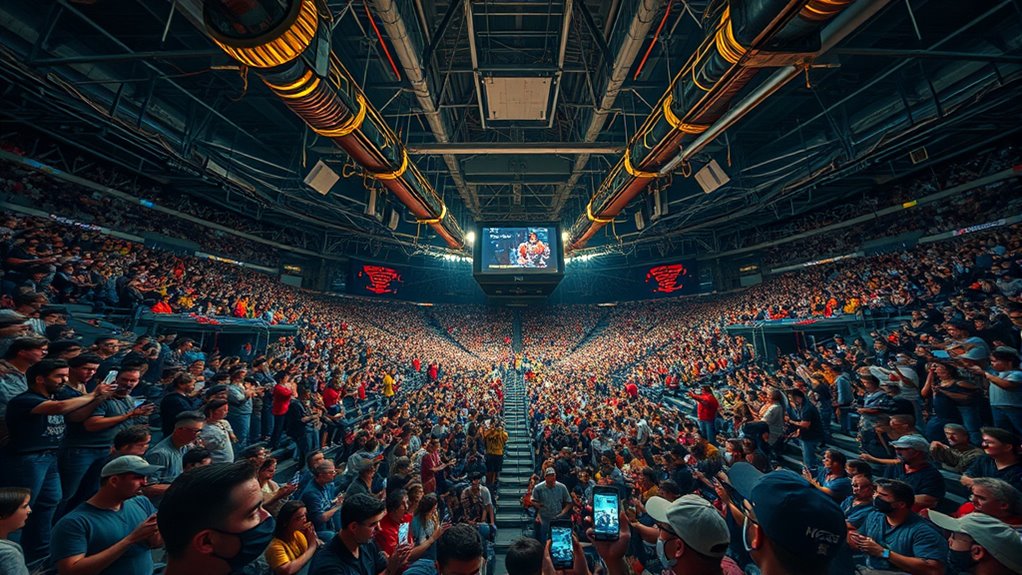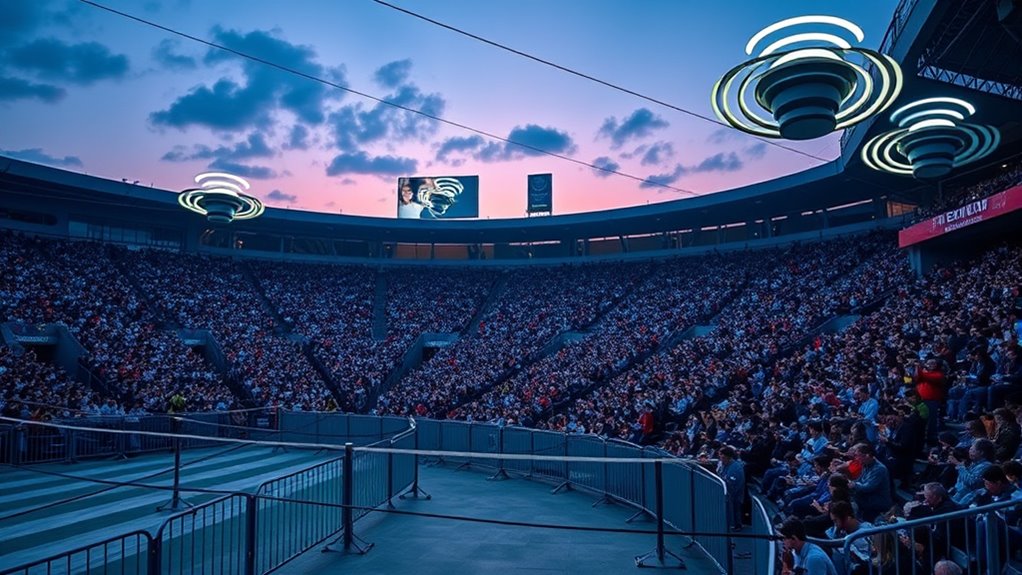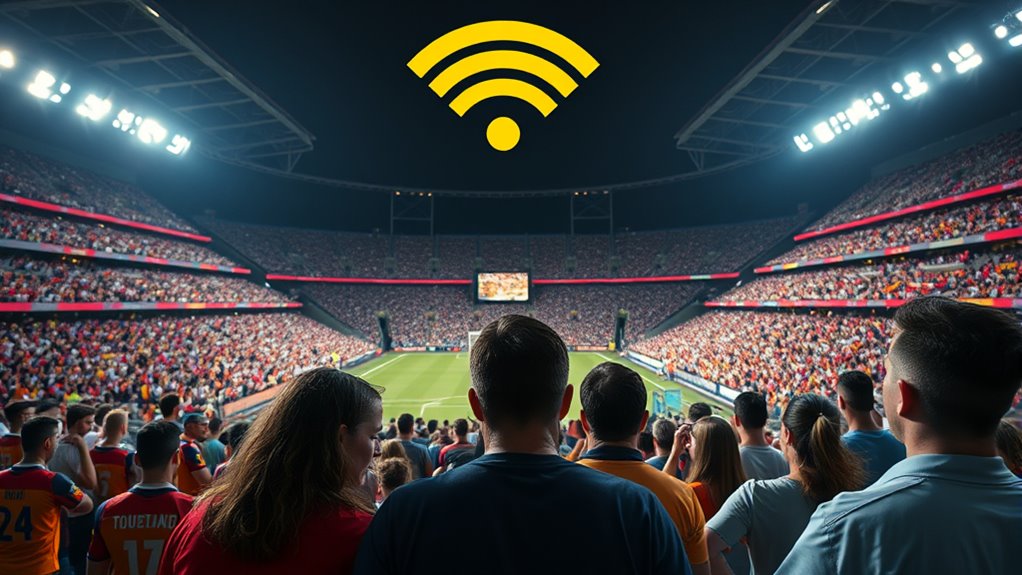Stadium Wi-Fi often fails because outdated infrastructure struggles to handle dense crowds and high data demands during major events. Physical barriers like walls and metal structures, combined with interference from devices, weaken signals and cause drops. Security concerns and limited management options further hamper performance. To improve, venues need innovative solutions like modern hardware, smart antennas, and scalable networks. Keep exploring to discover how emerging technology can finally solve these persistent issues.
Key Takeaways
- Outdated infrastructure and insufficient capacity cause congestion during peak events, leading to slow and unreliable connections.
- Physical barriers, dense crowds, and interference from devices weaken Wi-Fi signals and reduce coverage quality.
- Limited security protocols and poor access controls increase vulnerability and hinder scalable, safe network management.
- Lack of modern hardware and adaptive systems prevents effective handling of high user demand and data traffic spikes.
- Inadequate network planning and outdated technology fail to address evolving user needs, causing ongoing connectivity issues.
Overcrowding and High User Density

During major events, stadiums often experience overcrowding, leading to a surge in the number of users connected to the Wi‑Fi network. Your experience depends heavily on spectator behavior and how crowds move throughout the event timing. As more people gather in tight spaces, network congestion increases quickly, causing slow connections or dropped signals. During peak moments, like halftime or pivotal plays, many users try to access Wi‑Fi simultaneously, overwhelming the system. This high user density strains the infrastructure, making it difficult for everyone to stay connected. You might notice buffering videos, missed notifications, or difficulty sharing updates in real-time. Without proper planning for such spikes, the Wi‑Fi network simply can’t keep pace with the crowd’s demands during these overcrowded periods. Additionally, the limited capacity of the network hardware often cannot handle sudden surges in user density, leading to persistent connectivity issues.
Outdated and Insufficient Infrastructure

Many stadiums still rely on outdated Wi‑Fi infrastructure that struggles to handle modern connectivity demands. This often results in slow, unreliable connections that frustrate fans and hinder the overall experience. The infrastructure’s limitations can also impact venue aesthetics, as bulky antennas and obsolete equipment clutter the space, detracting from the stadium’s appearance. Additionally, ticketing systems that depend on outdated Wi‑Fi may process entries slowly or fail during peak times, causing long lines and missed opportunities. Without upgrades, the infrastructure can’t support high-bandwidth activities like live streaming or interactive apps. To improve Wi‑Fi performance, stadiums need to invest in modern, scalable systems that blend seamlessly into the venue’s design, ensuring both functionality and aesthetics are maintained. Incorporating AI-powered network management can optimize performance and adapt to fluctuating user demands in real-time.
Interference From Physical Barriers and Other Devices

Outdated infrastructure not only hampers Wi-Fi performance but also makes signals vulnerable to interference from physical barriers and other devices. In stadiums, concrete walls, metal structures, and dense crowds act as physical barriers that weaken or block Wi-Fi signals, reducing connection quality. Additionally, device interference from smartphones, tablets, and other wireless gadgets creates competing signals that disrupt data flow. These obstacles can cause frequent drops, slow speeds, and inconsistent coverage, frustrating users. Without proper planning and updated equipment, your network struggles to overcome these physical and electronic barriers. Moreover, a lack of proper network management can exacerbate these issues, leading to even more unreliable connections. As a result, even with a strong signal source, interference from physical barriers and devices can considerably diminish the quality of stadium Wi-Fi, leaving attendees disconnected when they need it most.
Security Measures and Network Restrictions

You might notice that stadium Wi-Fi often uses limited encryption protocols, which can leave your data more vulnerable. Access controls are usually restricted to prevent unauthorized users from connecting easily. Understanding these security measures helps you stay cautious while enjoying the network. Incorporating security best practices such as using a VPN can further protect your personal information on public networks.
Limited Encryption Protocols
Limited encryption protocols at stadium Wi-Fi networks often leave user data vulnerable to interception and unauthorized access. Many stadiums still rely on outdated or weak security standards, exposing encryption vulnerabilities that cybercriminals can exploit. Protocol limitations, such as using WEP or early WPA versions, fail to provide robust protection, making it easier for hackers to intercept sensitive information like passwords or credit card details. These security shortcomings stem from cost-cutting measures or lack of awareness, leaving users exposed during large gatherings. When encryption protocols are insufficient, your data isn’t just at risk; it’s an open door for malicious actors. Upgrading to stronger, current standards is essential, but many stadiums haven’t yet implemented these necessary improvements. Additionally, ongoing research highlights the importance of AI security measures to identify and mitigate emerging vulnerabilities in network infrastructure.
Restricted Access Controls
How effectively are stadium Wi-Fi networks controlling access to prevent unauthorized users from connecting? Access control is vital here, but many stadiums rely on basic measures like open networks or simple passwords, which are easy to bypass. Strong user authentication methods, such as multi-factor authentication or unique login credentials, are often missing or weak. Without proper access control, anyone nearby can connect, risking network congestion and security breaches. Implementing robust user authentication helps guarantee that only authorized attendees access the network, reducing unauthorized usage. However, many stadiums fall short of these standards, leaving their Wi-Fi vulnerable. Effective restricted access controls involve verifying user identities and limiting connection privileges, but these practices are not consistently applied, which hampers the overall security and performance of stadium Wi-Fi systems. Additionally, integrating AI technologies for real-time monitoring can enhance security by detecting suspicious connection behaviors and preventing unauthorized access.
Challenges of Scalability and Bandwidth Management

Scaling stadium Wi-Fi networks to meet the surge in user demand presents significant challenges in managing bandwidth effectively. As more fans connect simultaneously, you must balance user capacity without degrading performance. High user numbers strain existing infrastructure, causing congestion and slow speeds. To address this, signal optimization becomes critical—ensuring access points are correctly placed and channels are efficiently allocated. Without proper management, bandwidth gets divided unevenly, leaving some users with weak signals or dropped connections. You need scalable solutions that can dynamically adjust to fluctuating demand, but many stadiums lack this flexibility. The struggle lies in expanding capacity while maintaining quality service. Additionally, understanding power consumption of heated mattress pads can offer insights into energy-efficient solutions for stadium facilities, ensuring sustainable operation without compromising performance. Ultimately, without strategic planning for bandwidth management and signal optimization, stadium Wi-Fi remains unreliable and frustrating for users.
The Need for Innovative Technological Solutions

To meet the growing demand for reliable stadium Wi-Fi, innovative technological solutions are essential. Implementing smart antennae can direct signals more efficiently, reducing interference and boosting connection quality for thousands of users simultaneously. User segmentation allows you to prioritize bandwidth based on user needs, ensuring fans streaming live videos or accessing apps receive better service without sacrificing overall network performance. These advancements help address congestion issues that traditional systems struggle with. Additionally, integrating Kia Tuning concepts such as enhanced hardware and system optimization can inspire scalable solutions for wireless infrastructure, ensuring robust connectivity. By adopting such technologies, you create a more dynamic and adaptable wireless environment. This not only enhances user experience but also future-proofs your stadium’s infrastructure. In a competitive entertainment landscape, investing in innovative solutions like smart antennae and user segmentation is key to delivering seamless connectivity that meets modern expectations.
Frequently Asked Questions
How Do Stadium Wi-Fi Providers Prioritize User Connections During Peak Times?
During peak times, stadium Wi-Fi providers prioritize user connections by managing network congestion and bandwidth allocation. They often implement quality-of-service (QoS) protocols to make certain that essential services stay connected, giving priority to certain users or applications. You might notice that during these moments, your connection slows as providers dynamically adjust bandwidth, focusing on maintaining overall network stability rather than offering equal speeds to everyone.
What Role Do Venue Layouts Play in Wi-Fi Signal Distribution and Quality?
Venue layouts, including seating arrangements, markedly impact Wi-Fi signal distribution and quality. When seats are packed closely or arranged in complex patterns, they can cause signal interference, weakening connections. You might notice slower speeds or dropped signals in certain areas. To improve Wi-Fi, providers need to optimize placement of access points, considering how seating and walls affect signal flow, ensuring a more consistent experience for everyone in the stadium.
How Are Stadium Wi-Fi Security Risks Actively Monitored and Mitigated?
While it’s tempting to overlook security, you should know stadium Wi-Fi providers actively monitor risks through advanced intrusion detection systems and robust network encryption. These measures help identify unusual activity early and protect user data. By constantly updating security protocols and employing real-time alerts, they minimize vulnerabilities, ensuring a safer experience for everyone. So, your connection stays secure, even amidst the lively atmosphere of a packed stadium.
What Innovative Technologies Are Being Developed to Improve Stadium Wi-Fi Resilience?
To improve stadium Wi-Fi resilience, innovative technologies like mesh networking and AI-driven analytics are being developed. Mesh networking creates a robust, self-healing network that adapts to high user loads, reducing outages. AI analytics monitor network performance in real-time, quickly identifying issues and optimizing data flow. You’ll notice these advancements enhance your experience by providing more reliable, faster Wi-Fi, even during peak times, ensuring seamless connectivity throughout the event.
How Do User Behaviors Impact Wi-Fi Performance During Live Events?
You might think user habits don’t impact Wi-Fi performance, but social influence often drives people to connect simultaneously, overwhelming the network. When everyone posts, streams, or shares during live events, it creates a surge in demand, slowing speeds for everyone. This behavior, fueled by social influence, strains infrastructure, making it harder for the system to keep up. Your collective habits directly influence the quality of stadium Wi-Fi.
Conclusion
You’ve seen the hurdles stadium Wi-Fi faces—overcrowding, outdated gear, interference, and security barriers. It’s like trying to pour a waterfall through a tiny straw. But hope isn’t lost. With innovative tech and smarter solutions, we can turn this chaos into a seamless, lightning-fast network that fuels every cheer and selfie. The game isn’t over; it’s just waiting for a winning play to transform your stadium experience forever.









